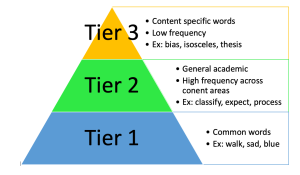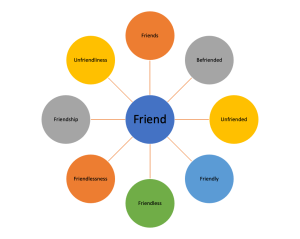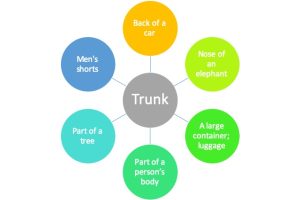9 Vocabulary
ESSENTIAL QUESTIONS
- Why is word knowledge important at the primary level?
- How do teachers select the words to teach?
- What are some methods of teaching vocabulary?
- How do teachers assess word knowledge?
Importance of Vocabulary
It may seem obvious, but it is worth stating anyway – the larger a child’s vocabulary the more likely they will be successful in school. They will be able to read and understand more complex texts, produce more sophisticated writing, and think in more critical ways. Studies across the years have supported this axiom.
In the early years, vocabulary knowledge is a predictor of reading achievement (Biemiller, 2003). Before entering school, children learn most of their vocabulary through their interactions with others, but once in school, the types of words encountered change as they begin to be immersed in academic language that may not match their language at home. The number of words that children need to learn is huge. On average, children should add 2,000 to 3,000 new words to their reading vocabulary each year (Beck, McKeown & Kucan, 2013).
Wide knowledge of words impacts children’s receptive and expressive language abilities, enabling them to comprehend more complex texts during read alouds and produce stories with more specific and descriptive words.
When children enter school, there is often a wide range of word knowledge and primary teachers need to support all children in developing their vocabularies. There have been several studies that indicate the income level of a child’s family is correlated to the amount and sophistication of words used in the home. Children from households with lower incomes tend to be exposed to few words and less nuanced vocabularies. Children from middle-upper incomes with professional parents can have an advantage in their language development. This gap can be as large as 15,000 words and, without intervention, continues to widen as the children progress through school (Moats, 2001). To close this vocabulary gap, vocabulary development needs to be accelerated through intentional instruction.
When we talk about a child’s vocabulary, we have a tendency to talk about it as a singular entity, however, children have multiple vocabularies that include different words and understanding of meanings. The four vocabularies that children have are:
-
- Listening (receptive)
- Speaking (expressive)
- Reading (receptive)
- Writing (expressive)
Children’s listening vocabularies tend to be their largest vocabulary and this is developed through read alouds and creating language-rich classrooms. Generally, a child’s speaking vocabulary is the next largest and is developed through interaction with others.
Once children begin to read, they recognize words in print and can use context clues to figure out the meanings of words. Children’s writing vocabulary tends to be the smallest of the four because children need to know the word and be willing to spell it. Many times a child will write a simpler word to replace more complex words in writing.
Children need to encounter and use words throughout the modalities to gain a sophisticated knowledge of the word with nuances of meaning. Therefore, when working with words in your classroom, remember to provide opportunities for children to practice hearing, speaking, reading, and writing words.
Types of Vocabulary
Not all words are created equally and knowledge of some words will provide access to better reading comprehension, writing sophistication, and critical thinking than others. Teachers need to be intentional and thoughtful about which words they select to spend time with children and which words can just be defined for children.
Three-Tiered Model of Vocabulary Development
Beck, McKeown, and Kucan (2013) have studied vocabulary development in children for several decades and they continue to refine their understanding. They designed a tiered model of vocabulary use which has been adopted by the Common Core State Standards.

Tier 1 Words – These words are the everyday words that children encounter. They are conversational, typically simple, and usually have clearly defined meanings. These words appear on high-frequency lists like the Dolch Word List, Fry Word List, or sight word lists. Often these word meanings will not need to be taught but will appear in phonics instruction and in the discussion.
Tier 2 Words – These words are typically called academic words because they are the most common words used in school and the workplace. They are important for the comprehension of texts – both fiction and non-fiction – and can impact the range of genres of writing children will have access to. Tier 2 words will be encountered across texts and subjects, may have multiple meanings, and provide more nuanced meanings. For example, “relative” can either be a family member or a comparison (relative to..).
Tier 3 Words – These words are content or domain-specific words that are required to understand a subject area. They would be unique to a unit of study or topic of an informational text. Examples include words like lava; aorta; boycott; hyperbole; or algorithm.
Understanding the three tiers can help separate the “should-know words (Tier 3)” from the “must-knows (Tier 2)” and the “already-known words (Tier 1)” (Tyson, 2013).
Brick and Mortar Words
Dutro & Moran (2003 ) further categorized Academic Words into two areas – brick and mortar words.
In the above video, Dr. Cindy Lundgren explains the idea of “bricks and mortar” words.
Brick words are keywords and concepts within a sentence, often nouns, verbs, and gerunds. Often these words are defined in the text, bolded, or found in glossaries. They may be Tier 2 or 3 words. Examples: plot, contend, civil rights, shadow, government.
Mortar words hold the brick words together and signal relationships between the words or concepts. They are connecting or transition words or phrases or prepositions. They are typically Tier 2 words. Examples: live, leave, notice, however, nevertheless, because, even though.
In the video Dr. Cindy Lundgren explains the idea of “bricks and mortar” where “bricks” are the key vocabulary words and concepts in a sentence, and “mortar” is the language (such as signal words and phrases) holding the bricks together. Here is the example she details in the video:
Even though bats have wings, they are not birds.
In this sentence, the bricks are the key vocabulary words in bold:
Even though bats have wings, they are not birds.
Yet to fully understand the sentence, students must understand the meaning of “even though.” Here is a sample definition:
“Even though” means that two items are similar, but they are not the same. In this case, bats and birds both share a similar feature (having wings), but they are not the same animal.
Vocabulary Instruction
Do you remember having vocabulary lists of words in school? Did you look them up in the dictionary, write down the definition, and take a test on them on Friday? This traditional method of “teaching” vocabulary continues in many schools, yet research across decades shows that it is the most ineffective method of supporting vocabulary development. Children need to explore both the breadth and depth of words – not just a definition.
The most effective way to develop word consciousness in your children is to create a print and language-rich classroom in which words are explored, played with, and used throughout the day.
Take a look at the table on the next page adapted from Tyson (2014). Best practices in vocabulary instruction include encountering words in context, multiple times, and through multiple representations. Children need to be actively involved in exploring and representing the meanings of words to gain a nuanced understanding of words.
| DO | DON’T |
|
Provide multiple exposures to words. New words are learned and meaning is shaped through many experiences over time. |
Introduce words and forget to review and reinforce them over time. |
|
Have students create non-linguistic representations for words – images, pictographs, and act out new words. |
Have students only look up the words in the dictionary and copy definitions |
|
Focus on academic word instruction – Tiers 2 & 3. |
Teach too many words at one time. Students will only learn words at a cursory level and quickly forget them. |
|
Support reading in a variety of genres and text types. Wide reading builds a rich, useful, and diverse vocabulary. Use high-quality children’s literature with advanced vocabulary. |
Rely only on leveled, predictable, or decodable books for word learning. Reduced or simplistic text may be easier but doesn’t stretch readers. |
|
Directly teach words. Pronounce it, spell it, provide a kid-friendly definition, and then ask students to use it. |
Tell students to look it up in a dictionary. |
|
Use digital tools for practice, review, and connecting words to images. |
Use one form of word practice – like a workbook or worksheet. |
|
Create a print and language-rich classroom with word resources available around the room. |
Expect students to investigate words independently using only print resources. |
|
Use a variety of assessment tools across time. |
Try to assess every word you introduce. |
Direct Instruction of Words
There are times that you may want to directly teach a word that will be used in a unit or text. However, be intentional and thoughtful about which words you spend time on for direct instruction. Select words that :
- are likely unfamiliar
- are critical to passage understanding.
- students are likely to encounter in the future and are generally useful
- are Tier 2 & 3 words (Academic Vocabulary)
- are easily explained to children at their level
Once you have selected a small number of crucial words, effective direct instructions includes providing context for the word, saying, spelling, and representing the word multiple times. You can use the following procedure to ensure children deepen their understanding of the word.
Introduce Vocabulary
•Step 1: Contextualize each word from the text – either in the reading or with your own sentence. Provide this in print so students can see the spelling of the word.
•Step 2: Explain the meaning of the word using student-friendly terms.
•Step 3: Children repeat the word so they can create a phonological representation of the word. Have them practice using it in a sentence.
•Step 4: The teacher provides examples in contexts other than the one used in the story. Students also provide their own examples.
•Step 5: Children say the word again to reinforce the phonological representation.
Develop Vocabulary
•Step 6: Students engage in activities that allow them to interact with words. These activities serve as a means for students to respond, explain and create their own examples. The teacher may ask students to draw or act out the words.
Maintain Vocabulary
•Step 7: Apply and use words in reading and writing situations
Graphic Organizers to Study Words
There are a variety of graphic organizers that can help you teach new words and provide children with a deeper knowledge of the word. Such typical graphic organizers include:
- Vocabulary Squares
- Frayer Model
- Knowledge Rating Scale (in the section about assessment)
- Linear Arrays
- Many other examples here: Vocabulary Strategies Toolbox
In the video above, a teacher describes the various ways to use the Frayer Model to teach vocabulary.
In the video above, the 2-minute mini-lecture demonstrates and describes visual displays and graphic organizers used for vocabulary instruction by Dr. Andy Johnson, Reading Specialist.

Word Part Instruction
It is estimated that more than half of the words used in English are formed from their Greek and Latin roots (though that percentage increases in the sciences). Many English words are formed by taking basic words and adding prefixes and suffixes to them. Children can access the meaning of more words if they are introduced to the meaning parts of words because a single root word can be used to create dozens of other words.
Root – the smallest part of a word that carried meaning; the base
Affix – the umbrella term for prefixes and suffixes
Prefix – an element added in front of a root word or base word that changes or expands its meaning
Suffix – an element added at the end of a root word or base word that changes or expands its meaning
There are some nice examples of word part activities at Miss Giraffes’ Class Prefixes and Suffixes Teaching Ideas for First Grade and Kindergarten.
Assessing Vocabulary Knowledge
As we have emphasized across this textbook, assessment of children should inform instruction and take a variety of forms and this is true with assessing word knowledge.
The most common form of assessing vocabulary knowledge is the multiple choice question, but you need to be critical about how much information this provides on word knowledge. Here are several ways of presenting vocabulary questions (college-level words):
Superfluous means: 1) insufficient 2) excess 3) awesome 4) fallible
Superfluous means: 1) a small mountain 2) causing insidious harm or ruin 3) being more than enough 4) lofty with pride
Needed is to necessary as superfluous is to _____. 1) expendable 2) useful 3) indispensable 4) honest
What type of thinking is needed for answering these types of questions? Does it show a deep understanding of the word?
Self-Rating of Vocabulary Knowledge
What does it mean to “know” a word? Dale (1965) suggested that word knowledge is a continuum of the depth of knowledge. Before teaching a word, it is useful to pre-assess how much knowledge children have about the word according to the following descriptions:
- No knowledge: Never seen or heard it before.
- Some knowledge: Have heard or seen it before. Have a general sense of what it could mean.
- Know the word: Could give a definition or examples of it.
- Extensive knowledge: Could give a nuanced definition of the word, its multiple uses, and contexts.
With young children, you can ask them to give a thumbs up, sideways, or down to indicate their knowledge of the word. For older children, you could have them rate their knowledge on a graphic organizer like the table below (using college-level words).
| WORD | DON’T KNOW | SOME KNOWLEDGE | KNOW THE WORD | KNOW THE WORD WELL |
| acumen | ||||
| egalitarian | ||||
| halcyon | ||||
| milieu | ||||
| pernicious | ||||
| sardonic | ||||
| vociferous |
You can also have conversations with children and ask:
*What does this word mean?
*Can you give me an example of the word?
*Tell about a time you did/felt/experienced this.
Semantic Map (Word Webs)
Select an important word for the focus of the web and place it in the middle. Ask children to make connections to the word with images, words, or phrases. As a teacher, you can see the depth of word knowledge through this activity.

Concept Sorts
In a concept sort, children are provided a list of words and they have to sort them into categories – either pre-determined by the teacher or an “open sort” determined by the children.

Language Recognition Task
Useful as a pre-test/post-test for a topic or unit, the language recognition task is a variation of a sort. To create this assessment, create a list of words related to the topic interspersed with words that are unrelated. Children need to circle the words related to the topic. For an example of a language recognition task for rocks, check Second Story Window Primary Teaching Resources and scroll to the bottom of the page.

Modified Cloze Test
In a cloze test, words are deleted from a reading passage and the child is asked to provide a word that makes the most sense based on the context. You could provide three choices for the blank as a modification.
To score a traditional cloze test, you would count up the number of words the child replaced exactly (not counting spelling). However, there is value in recognizing a child’s use of synonyms too.
A Cloze Passage About Frogs
A frog is an ______, which can live both on land and in ____. They lay their _____ in water. The eggs hatch into a ______ which lives in water until it changed into an adult frog. Tadpoles look more like fish than frogs, they have long finned ____ and breathe through ____.
Observe Children’s Work
The most authentic way to assess children’s vocabulary is to listen to them talk and examine their writing. Since expanding their vocabularies is the goal of vocabulary instruction, taking note of the words they actually use is the best indicator of word knowledge.
Review and Questions to Ponder
Questions to Ponder
- Reflect on your own experiences with vocabulary in school. What were the most effective strategies for you personally? How might this influence your own instruction of vocabulary?
- We tend to think about vocabulary instruction as a direct and teacher-led activity. What are some ways that students can be active in their own learning of words? What are some indirect ways to help students learn new words?
References
Beck, I., McKeown, M. G., & Kucan, L. (2013). Bringing words to life: Robust vocabulary development. New York: Guilford.
Biemiller, A. (2003). Vocabulary: Needed if more children are to read well. Reading Psychology, 24(3-4), 323-335.
Moats, L. C. (2001). When older kids can’t read. Educational Leadership, 58(6), 36-40.
Tyson, K. (2013). No tears for tiers: Common Core vocabulary made simple. Learning Unlimited.com. Retrieved from http://www.learningunlimitedllc.com/2013/05/tiered-vocabulary/
Tyson, K. (2014). 10 Do’s and Don’ts for Effective Vocabulary Instruction. LearningUnlimited.com Retrieved from http://www.learningunlimitedllc.com/2014/01/infographic-10-dos-donts-effective-vocabulary-instruction/

